Dōjō-ji Temple
- Address: 1738 Kanemaki, Hidakagawa, Wakayama Prefecture
- Tags:
 What to see Wakayama,
Wakayama,
Japan
What to see Wakayama,
Wakayama,
Japan
- Website: http://www.dojoji.com
Visiting the famous Dōjō-ji temple
Coming up next on the stage is the famous temple Dōjō-ji from the Gobo (Hidaka). This temple was my first Buddhist temple I have ever visited in my life and also my favourite one. Why is it special and why I love it we are going to find out right now.
It was the Day 6 of my stay abroad in Japan when I went with my host mom Mieko on small trips around for the whole day. After having a breakfast at home and working a bit at our restaurant Anchin she told me that we were going to visit Dojo-ji. I mean, she tried to tell me and after a minute I got it we were going to go somewhere. Then she pointed out in the direction of the temple and said 'Doujou-ji tera' and everything was pretty clear. By the way, the entrance of the temple, the stairs that were climbing up the hill, were about 100 metres from our home and the restaurant. How cool is that?
First time approaching the temple
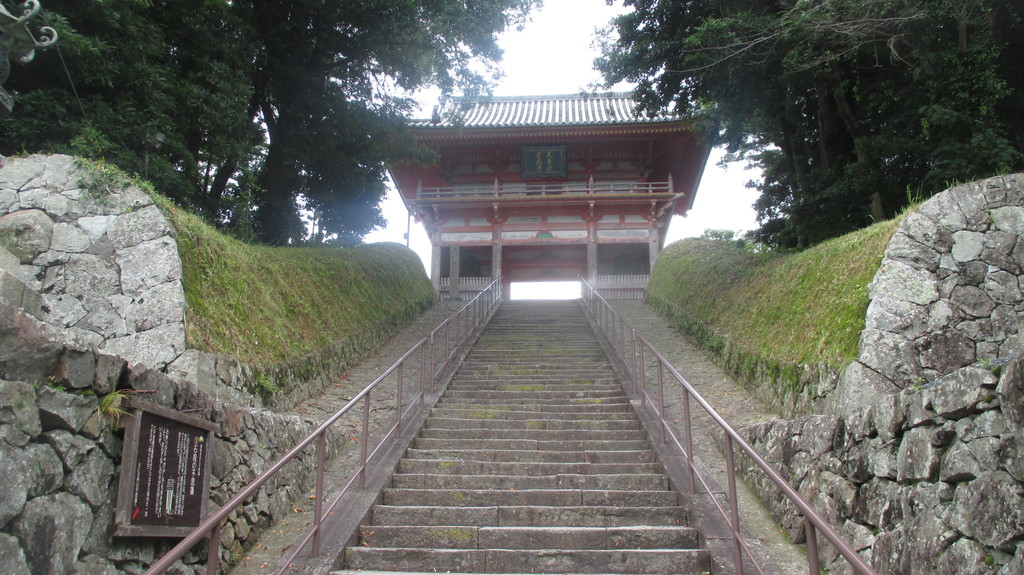
As I mentioned the stairs that were leading to the reddish-orange portal were about a minute of a walk away from our house and the restaurant. After the first night in Japan (I came the day earlier in the evening regarding the local time and went to sleep) I had a breakfast and decided to take a walk around the area with all the available cameras I had. After slowly and thoroughly exploring the area, observing the details, I made a small circle around the neighbouring streets and that's where I also saw there were some stairs climbing up the small hill (maybe 15 meters above the ground level).
What I saw at their end was the reddish-orange portal and I presumed that it must be part of some temple or sanctuary. Next to the stone stairs were two kind of rocks or stones serving as a column with engraved Japanese characters. I had no idea back in the time what they meant. And still not quite sure what it said but I guess it must have mentioned the name of the place. I did a few steps up the stairs but then quickly decided to come back. I felt it would not be a good idea to just pop up up there and did not know what to expect. I also did not want to be like "a typical ignorant Western tourist" who just goes everywhere without respecting the local culture. Since I came through the street with several shops and markets I did not want to look stupid or do something not knowing what. So I just took a photograph of the stairs and decided to wait for the next time hoping someone would explain me more of the place at home.
Visiting Doujouji for the first time (now for real)
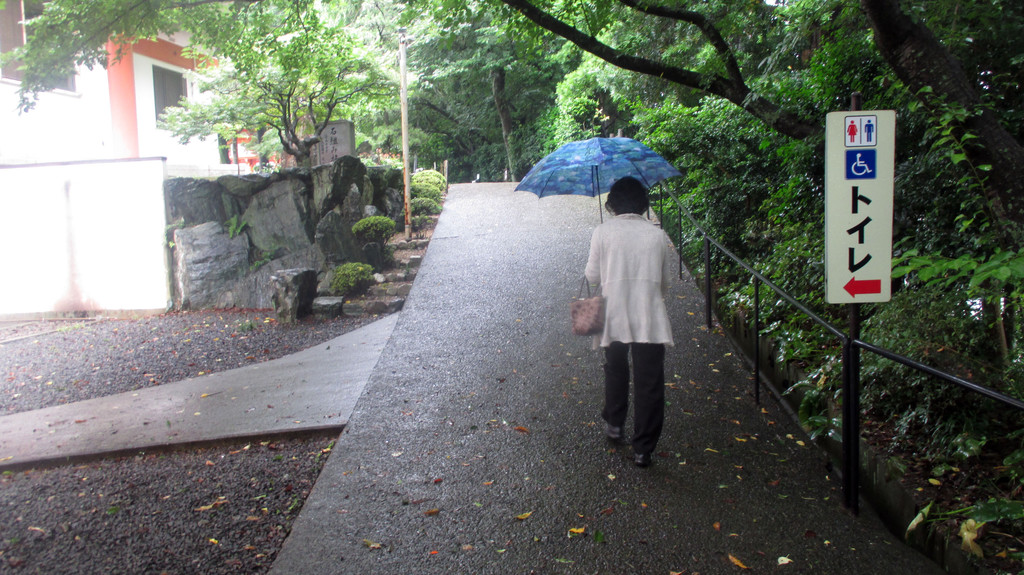
But yes, the day has come! On the 6th day mom took me into the car (yes, and here is why) and took me to the temple. We went by car as we planned to go directly to the town centre for the lunch later. I mean, she planned that, I had no idea what was happening of course. So far I was aware of the two entrances to the temple of Doujouji. The first one are the stairs that are practically the end of the street with many mini stores with ingredients and the restaurant. The other one is actually the road where you can go up by car. The road goes as a curve around the hill and soon you are there at the modest parking lot.
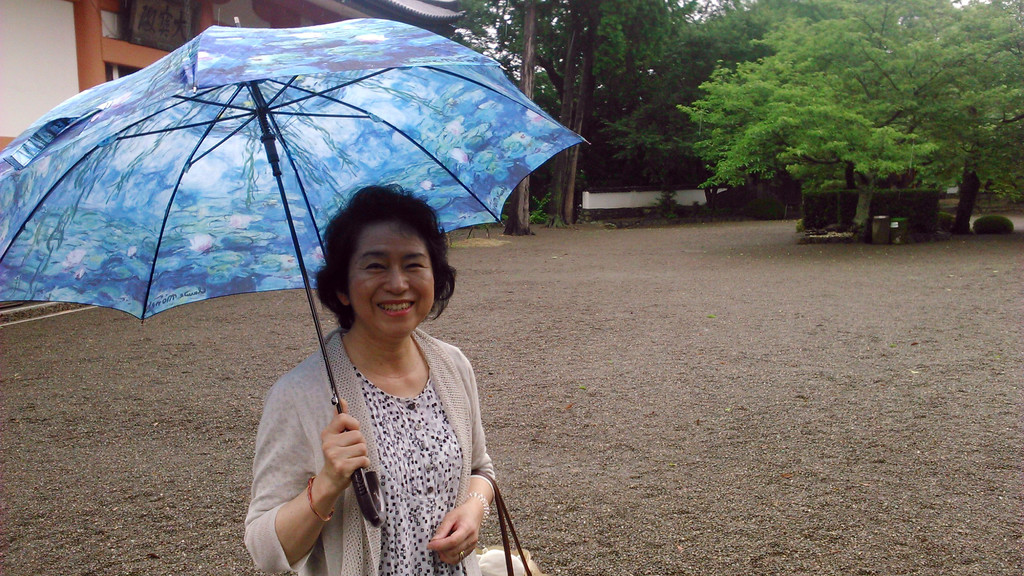
The parking lot was not meant to be overcrowded but has space for a few buses maybe. If there are more visitors, by bus respectively, there is a big parking lot in front of the Anchin restaurant. I remember seeing the guests arriving by bus everyday there at this parking while I had been working at the restaurant.
Great. But where is this Doujouji temple located?
The temple is in Gobo (Hidaka) town which is the part of Wakayama prefecture which is again part of Osaka Kansai region. Gobo and Hidaka are in the southwestern part of the Kansai region and peninsula. For foreigners flying by airplane to Osaka KIX airport it takes about an hour or so on the highway until you reach Gobo.
Finally passing through the orange portal and learning the customs

Back to the temple. The small parking lot on the hill is right behind one of the main buildings. Now we are going to walk on the road for passengers (and maybe those with bikes) only. It goes around the building and then you enter the huge yard of the temple or the complex of several buildings (as I find it more precise).
I remember seeing first lots of special trees carefully planted in the yard, one temple in the middle and some very Japanese-like tower to its right. The last thing to the right and right in front of me was the orange portal. Everything else was in general gray-black-orange as you can find it in Japan pretty much everywhere.
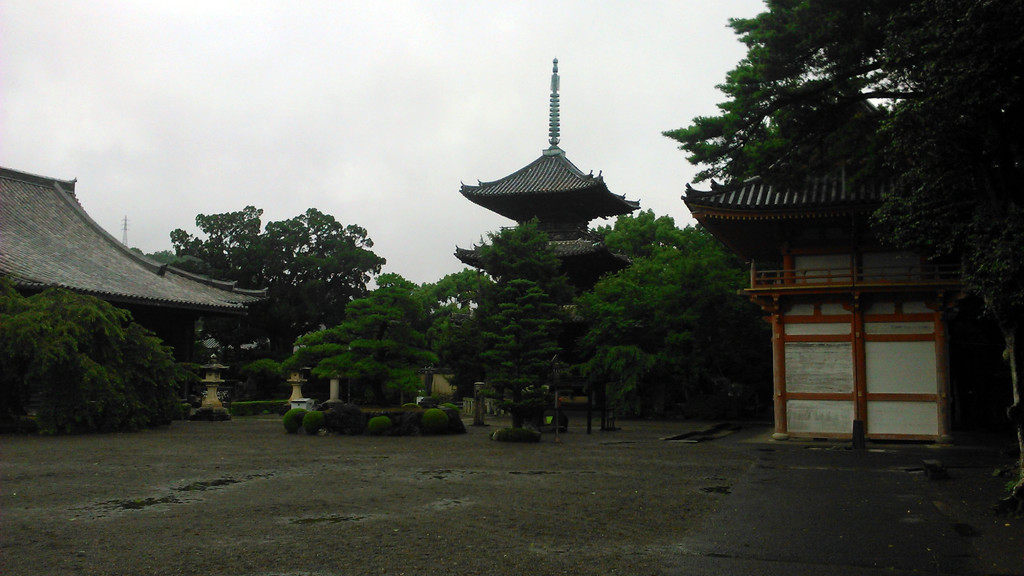
Since it was raining a little bit and the whole day was cloudy (the heavy rain had caught us in the afternoon and ruined the plan of mom Mieko to show me one of the sightseeing in the west) we took our umbrellas and went around. I forgot to mention that there were no other people in the area. There was one citizen walking through the yard but the moment we went there he was already about to leave in the same direction we came. Personally I prefer it if I go somewhere to some place I want to explore or learn something new that there are no other people who just disturb, stand on my way when I want to take pictures, etc.
Mom Mieko pointed me the orange portal and wanted to show me the customs and rules of how to properly enter the sacred area and the temples. We went on the outside of the portal back to the stairs and then I started following her and repeating what she did. First when you get there before entering the portal you should bow twice. I also had a chance to see the details around. There were some sculptures in the corner, the first guess would have been it was Buddha. There is also the swastika symbol on the gates, an ancient Sanskrit symbol that the Nazis have unfortunately taken for their propaganda and abused. Since most of the readers know from history what Nazi corrupted Swastika looks like, the original one that can be found here is not mirrored. Or it will look mirrored to you when compared to the one you know from history classes. By the way, I read recently that they are considering removing these symbols from the temples and the maps in Japan to avoid ambiguity and confuse or scare the tourists away. But I hope they do not do it as it has nothing to do with the WW2 Germany and the ideologies.

After passing the portal properly we headed now forward following the tiled road. Several days later and in 2 weeks on my day of the flight back home I went through the portal alone to greet with a monk and a friend of mine and was happy to know how to behave thanks to the teaching of mom Mieko.
Washing the hands before anything else
This building in front of us that had many statues and where we were supposed to go was surrounded with one small canal filled with water and lots of vegetation around. There was a pretty nice little bridge leading you above the water. But before we got there one has to do the hand washing.
On half of the way to the temple there was something like a little well with a long wooden scoop and the metal ending to grab the water. Here is what you have to do (if I remember). First you wash the left hand. You take the scoop with your right hand and grab the water. Then you wash the first hand. Now do the same vice-versa. After washing your hands you are now probably clean and ready to go there to the temple. This is similar to Christianity where washing represents cleaning of troubles and sins. I had been following again everything what mom Mieko was doing and kept repeating it.
Now we are ready for the next phase.
Standing before the temple, statues and igniting the wooden sticks
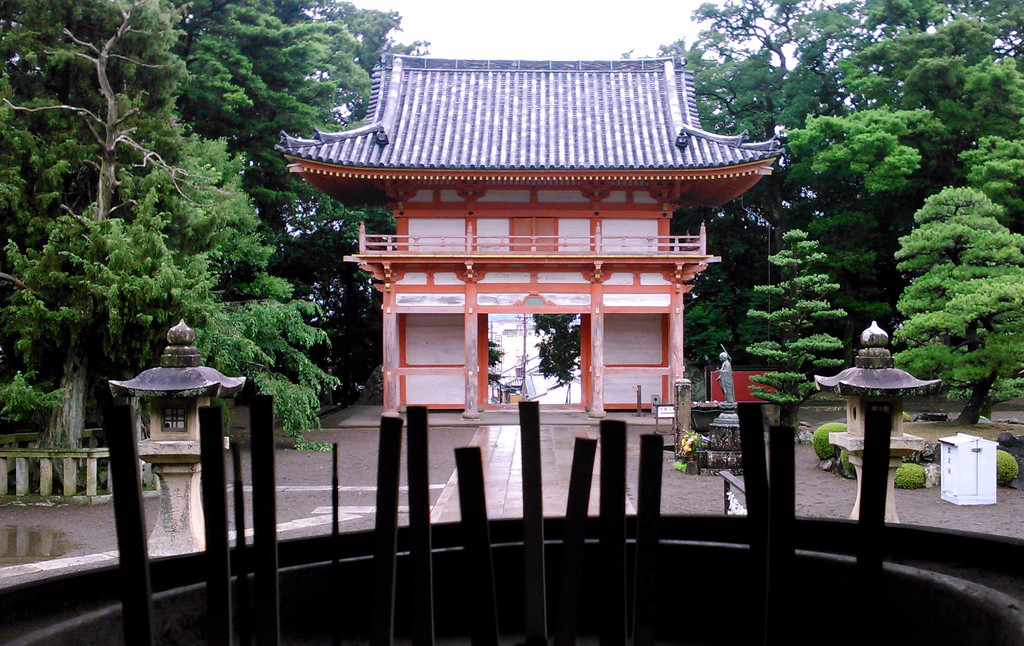
We crossed the little bridge to the other side and found ourselves in front of few stairs. There were several things I noticed. Next to us was a big dark pot or kind of a bowl filled with ashes or some kind of a powder. Except for that there were many wooden sticks put inside. It seems they had been ignited by the visitors. I did not have to wait long to see what really happened.

Mom Mieko showed me again what to do in such situation. We had to bow again and she pointed me some statues on the other side (you cannot go there) and told me their names. I could not follow much and got confused. I asked her about the thing with the wooden sticks and she went to demonstrate how to use them.
One inserts a few coins into a big wooden box that can be found at all the temples and these kind of places. It is kind of a small donation and appreciation for using the materials there and in general showing respect. We took then two wooden sticks and ignited them. Once the smoke starts to rise you go around it with your hand and try to "catch" or "grab" the smoke and then "pull it over" your head and shoulders again symbolising some kind of cleanliness. At least that's how I understood it from the perspective of the Catholic Church. It is almost always the case about cleaning your body and soul physically and metaphorically when entering such places.
After we had been done with everything I asked her to wait for few minutes so I could record everything I had around me. Then we headed to the main building and...
Meeting Mr Ono ("that awesome guy from the temple") and the story of Dōjō-ji
We were about to enter the first building we passed by. From the outside it seems that there are at least 3 main parts which might have a huge hall. I was feeling excited to check the interior and had no idea what to expect.
And it was inside when meeting the boss there (at least from my perspective) that I learned many things and some interesting facts regarding the restaurant I was helping at!
At the entrance you can find a place to leave and lock your umbrella. The part of me that was still psychologically bound to the manners from Croatia was pretty suspicious about this but then I immediately remembered I am at totally different place and mentality. After entering into the welcome hall and reception we had to proceed again with taking of the shoes. I got totally used to this pretty soon since my arrival to Japan and after coming back home I was taking off even my slippers in front of the toilet or bathroom automatically. Now, I observed quickly the space around. To your right you will find the information table and lots of learning and promotional material about Doujouji, something like souvenirs and the other stuff I could not guess their purpose. For instance, I got here for my friends a few little, I am not sure if the 'amulet' is the right word but they look like the little objects with messages and we would related to bringing us good luck. Something like fortune artefacts. Well, more of them when we come to the part explaining their meanings.
To our left was kind of a rack or a cupboard to leave our shoes. One would put off their shoes, stand with the feet on the wooden plank connecting the two floors and put them inside in a plastic bag that was provided in the box nearby. Then you are ready and allowed to go explore the other rooms and halls of the building.
Once we entered it Mom Mieko spoke to one young Japanese man working there and within a minute or two came with someone else. This is where I met Mr Sunjo Ono, the Buddhist priest working at the Doujouji temple and (at least for me) the boss of this place. He is the one who welcomes numerous visitors of the temple and opens its doors every day, pays attention that everything is in a good condition. Moreover, Mr Ono speaks very good and fluent English that can compete with Europeans and better than many of those whom I met in the high school or abroad. He studied Hindi in India and also learned English there and thanks to his skills he is invaluable member at the Doujouji community. I was pleasantly surprised and happy when he turned to me and spoke in English though I tried my best to use my very modest Japanese.
It was the first decent conversation I had in English since I came to Japan (with a few exceptions in the beginning) but here I was able to express everything I wanted and also received more or less the same amount of information without any troubles or language barriers. Thanks to Mr Ono who had share his time there to guide us around I learned many things not only about the Doujouji temple and its stories but also about the region, culture and its history in general. It felt really great and not that foreign having someone like him just in the neighbourhood few minutes away. He was very friendly and communicable as well as curious about my cultural background (and he already knew a lot). You will not be surprised that when we visited Doujouji with the camp two and half weeks later (and that was one of the best feelings too - coming shortly back to my old "hood") Mr Ono earned the biggest respect of all the priests and temples we had seen and heard so far and was officially known as "that awesome guy from Doujouji". Read further please.
The moment you enter this building you will notice hundreds of photographs of a woman in a red dress with the white face and special hair style prepared for the dance. I was curious about it and who that person was. All the pictures were on the frames next to each other. Some were the photographs of the woman dancing or posing while the others were illustrations. Mr Ono explained me it represents Kiyohime (and there was some important actress, I forgot her name, who played Kiyohime on the stage), one of two main characters of the story I was about to hear and the legend that had lots of things to do with the temple and the area.
Mom Mieko, Ono-san and I then headed straight to one of the two halls. From both sides of the hallway there were the photographs and illustrations depicting Kiyohime. Going through this passage it was actually a connecting bridge between the two buildings as to my left I saw the parking lot and to the right the yard where Mieko and I were a bit earlier. Then Mr Ono opened the doors of the hallway. I was a bit behind as I was looking at the portraits and the ceiling of the hallway and then got really surprised (pleasantly again) with what I have seen.
The national treasure of Japan
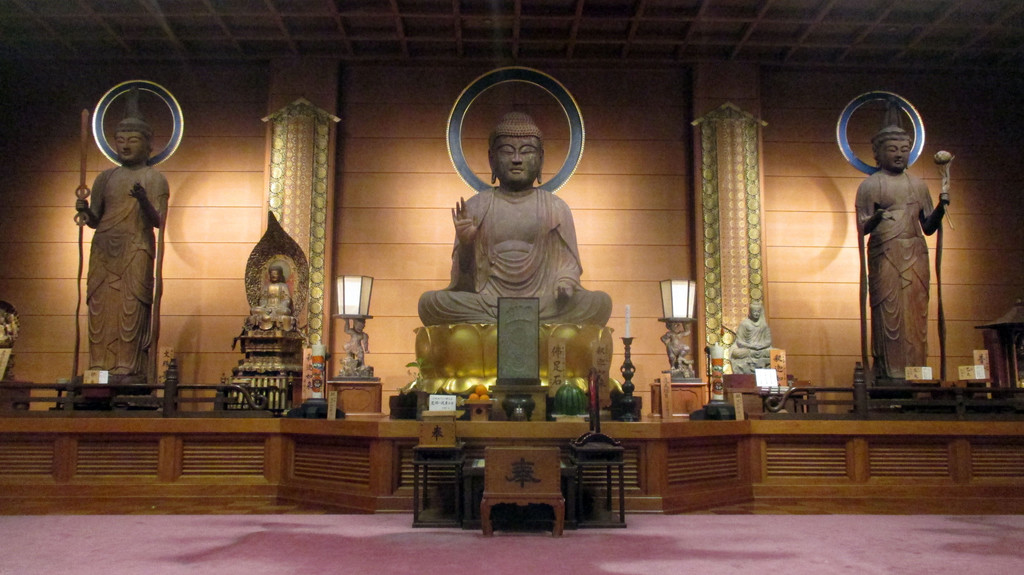
It was not about the gold or some jewelries of that kind, if your first though was something shiny. Once Mr Ono turned on the lights in the room it appeared that the room was actually a big hall filled with the statues. Some statues were about 700 or more hundred years old. And the place looked totally cool and interesting. I got instantly curious about the objects my eyes had seen and did not want to waste the opportunity to learn a bit more about them.
- I also documented a video of the interior. It is private and you can access it only by clicking here. I hope you will like it.
Knowing that usually one is not allowed to take the photographs of the artefacts at this kind of a place I was putting my cameras into the backpack but Mr Ono told me that we could do an exception for today since I am not there every day and that I can record everything to keep it as a memory and share with my family and friends. I am also going to show you a few photographs of the interior and the exhibited statues.
As we all know from our school days things we see on the photographs are not as same as you being there in front of it and being able to touch it. Thus for me too was a special experience to be surrounded with them and knowing the value and stories they had behind them.
Once you enter the hall the first statue you are going to see is the huge one of Buddha sitting on the other side of the hall in the middle of the wall. This statue of Buddha was the biggest statue that is being kept there. Buddha holds up there his right hand. And there are two more statues of Buddha, one to the left and to the right. They look thinner and are standing. All of them have something like a circular "areola" around their heads, similar to Western depiction of the holy heads with the yellow filled circle. If I am right the huge Buddha in the middle was made in Japan (or imported from China? ) and the two others came from southern Asia. One is from India or Pakistan and they have a bit different facial features. Which is natural as it shows the cultural background of the statues and the regional influence and the understanding of the story. If Buddha or Buddhism was spread in Europe the statues depicting him might have looked like me. When looking to the left and the right wall you will notice again two warriors on both sides with different kind of the armour. Again, it is because some of them were imported from other countries and cultures. Since I am no expert in Asian history I could not see the differences at first until Mr Ono let me pay attention to them stating that the Japanese armour around the soldier was pretty different to the one from China.
The story of Buddha, The Long-haired Princess and Kannon
I got to hear some stories about Buddha, Buddhism and the philosophy in Japan. In the religion or philosophy of life in Japan there are no gods unlike the other three-four world religions. As Mr Ono said the Japanese took a bit of everything and tried to use the best out of it. Thus there is a mixture of influences of Buddhism, Shintoism and Confucianism though the elements of Buddhism are the prevailing ones. Since Buddha was just an ordinary human, nothing divine within him, here comes the simplified story. Buddhism is about finding the right path that leads to the truth and working on ourselves, to improve as a better persons to the others and towards ourselves. In each of us is one Buddha and everyone throughout our lifetime can achieve the status of becoming Buddha. And Buddha means 'the enlightened". There is also something including karma where everything we do in our life, good or bad deeds, affects our future. If we continue with the good deeds the good will return back to us. And if we are not... well, there will be problems and we will not be satisfied with our situation, bad things will come up. One could also add the reincarnation (I am not sure people believe in it in Japan) where we do not go to things such as hell or heaven but simple are being reborn in a new life form. There is the circle of life, the wheel that keeps rotating forever.
But let us go back to our temple and the statues. Since many of you have already listened about Buddhism a bit in schools I think there is no more need to talk about it. I am more fond of telling a bit of the other two characters. You might have heard for the one but for the second I really doubt!
Our second persona here is the thousand-armed Kannon. There is a wooden statue of him. Along with two more Bodhisattva statues in the hall he belongs to the National Treasure of Japan. This wooden statue dates back to the 9th century making it more than a millennium old! Though there are no gods in which the Japanese believe today Kannon represents the deity of compassion and mercy. He or she is represented as a male or a female with thousands of hands and is one of the most popular and beloved deities of Asia. I will stick to this persona as a male. What makes him special? What I remember from Mr Ono's stories Kannon is there to help us in situation when we feel helpless, when distressed and in a trouble. There is an artefact with symbolic meaning in each of his hands except for the one. The artefacts represent things such as knowledge, medicine and many other aids and invaluable help to the humanity. So, when we are in a bad situation we should pray to Kannon. However, I mentioned the empty hand which should warn us that the biggest problems in our lives are going to be solved only by our own efforts.
The last is the legend of the Long-haired Princess and the wife of the 42nd Emperor of Japan. The story took place about 1 300 years ago. The local traditional stories claim the temple of Doujouji was founded by her. And here is what happened.
Miyako was born in the area of present Hidaka/Gobo but without a hair. Her parents were trying to do everything to make her hair grow but everything was in vain. One day in the nearby sea something mysterious was shining at its end and the fishermen were unable to catch the fish and find the reason why this was happening. No one was brave enough to dive and find out what was going on there. However, the mother of Miyako believed there might be something related to her child and she was courageous enough to go to the bottom of the sea. There she found the image of Kannon and took it home where she prayed to it every day. On everyone's surprise Miyako started growing her hair. It was a long beautiful black hair. Soon she was invited to a home of some important political person in Japan, such as the minister, and later on sent to the Emperor's Halls to serve there as the rumours and fame of her hair spread around. After some time she became a bride for the future Emperor. She spent her life there living as a princess but did not also forget on her parents, the area and the image of Kannon that was left home. The emperor seeing his wife worrying about her family told her not to worry about it and ordered to build a temple there. The name of the temple is Dōjō-ji.
The legend of Miyako can be read from the picture-scroll telling us about her life. And I was about to listen to another story from one picture-scroll!
There is a smaller statues of Miyako with her hair on the bed to the left side of Kannon.
The last thing in the room was this "amulet" for the Chinese Zodiac signs. There were smaller statues with the boxes where you could donate something and notes with written years. The first one I saw and asked what they represented was mine - I saw my year 1993 there and when telling Mr Ono that this statue and the persona was then "my protector" or representative Mr Ono translated it to mom Mieko who was happy as her year was there too so we both shared the Chinese Zodiac sign. The sign I got is said to represent the friendship, fire and support and should help the individual in with this traits. It say that people being born under this sign are the ones who are going to support the others and are pretty dynamic. The guy (I forgot his name, the statues I mean) is also going to help me when in trouble and always push forward. Mr Ono also said it is a guide and a support to the individuals on training which was fun since I was going to have my first training doing an internship in Vienna (right now when I am writing you this I have already been done with it and moved to another Austrian city to do the internship). Be it a truth or not it was very interesting.
Mom Mieko bought me one of these and since the day I got it on 6th July I have kept it with myself all the time, especially upon our arrival in Zagreb there was no single day that it was not without me. Even now I keep it (and have been keeping for months) in the pocket of my jacket and so far I have been pretty lucky with everything.
The story of Anchin and Kiyohime on the picture-scroll
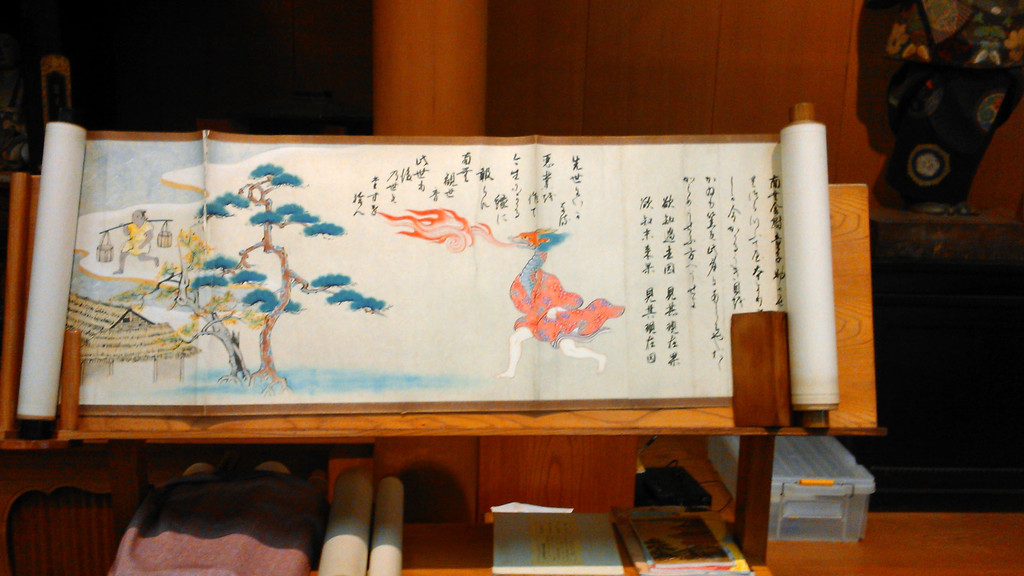
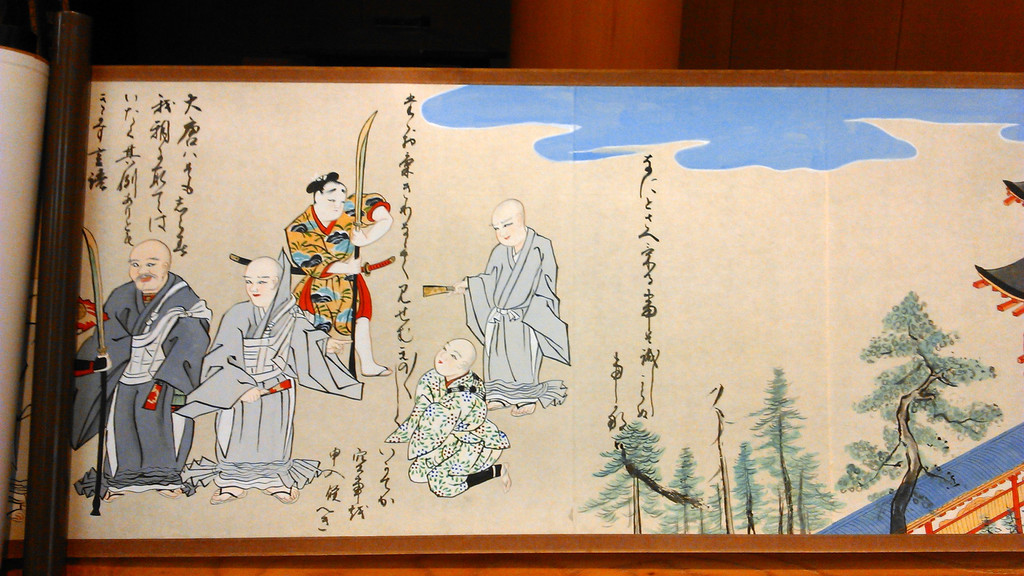
After taking videos and photos with my Canon and mobile phone camera and being done with the tour around the hall Mr Ono said there was one more hall to visit.
We turned off the lights, closed the doors and went back through the same passage almost to the entrance room. But there we enter to our right into another hall, I might say bigger than the previous one when talking about the surface of the room.
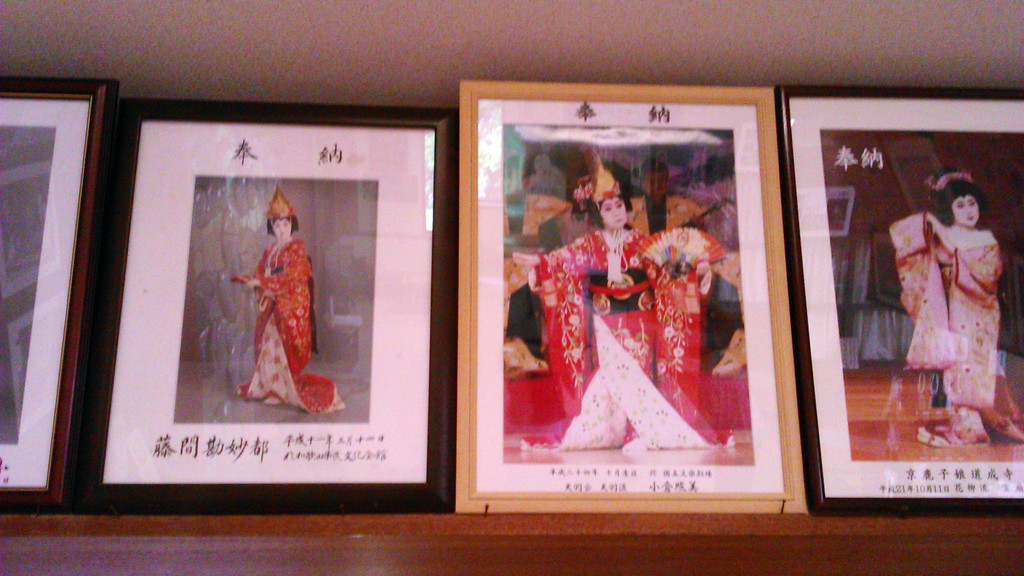
Unlike the previous space with statues that had walls without windows and other light except for the artificial one and the doors where the light would come from the hallway this room had big windows on two sides of the hall. Again, there were numerous different size pictures and illustrations of Kiyohime during the drama-adaptation with the Kabuki dance. The term Kabuki refers to the classical Japanese dance-drama with the stylised characters and remarkable make up the actors wear. One more notable thing in the room you cannot avoid and not-see is the huge bell. It looked pretty familiar to me but could not remember where I had seen it before. And right to the doors of this hall there are some glass-protected storage with the original pages of the picture-scroll story.
We walked towards the end of the room. I cannot remembered everything I had seen there but there was a wooden stand where one would put the scroll and stretch it form one till the other side in order to read it and for the audience to follow the story written on it. I remember one more portrait-illustration of Kiyohime in the upper right corner next to the window.
Mr Ono told me and mom Mieko to sit in front of it with comfort as we were about to listening to the story of Anchin and Kiyohime. Anchin?! I quickly turned to the bell and pointed also behind it as the restaurant Anchin was pretty close. Mr Ono laughed and said that the restaurant is named after the pilgrim Anchin who is one of the two main characters of this story. As for the bell I saw it in the restaurant but did not pay much attention to it (later on I checked every bell we had there! ). The bell or in Japanese "tsurigane" was also the shape of the cookies I was packing back in the restaurant. I have seen hundreds of them (and ate some of them, I miss them now so much when they were nice warm after production) but could not link them immediately with the temple. Anyway, Mr Ono took the picture scroll and and stretched it over the wooden stand. On the first half of the meter or more was the written text in Japanese in columns without many illustrations. He read it first in Japanese and then translated into English. Mom Mieko already knew this and heard it probably many times so during the storytelling in English she probably followed everything in Japanese. Let me tell you in short what happened. Ready?

The story of Anchin and Kiyohime is another very old, ancient legend whose tracks date back to the literature in the 11th century. It is a tragic story that took place at the Dojoji temple about 200-250 years after it's foundation. I found a date the event happened in 923. So... once upon a time on the river banks of Hidaka there was a wealthy family which had a daughter called Kiyohime. And as it usually goes they were on a route towards some popular pilgrimage sites and thus many pilgrims passed by their estate every day. They were even offering a stay for the tired pilgrims, something like a modern Couchsurfing. One day to Hidaka came some young handsome pilgrim called Anchin. He was given a shelter and comfort of a home at Kiyohime's family. You can probably guess that they fell with each other in love and Anchin postponed his goal towards the ascetic sites for some time. He even promised her a marriage. Kiyohime had grown very fond of him and the life of two together. However, after some time Anchin remembered his goal and succeeded to overcome his feelings towards Kiyohime. He did not want to stay forever on their estate and wanted to move forward without some clear plans. He left Kiyohime saying (or promising) he would come back after he is done with his pilgrimage. But he did not. Kiyohime started to worry about him and decided to go alone after him in the world.
She was asking the other pilgrims and travellers on the route towards the place Anchin was mentioning but the others were not able to help her. And the name of the place he was going to visit was Kumano. She went further on alone and soon found out Anchin passed this way and was in Kumano. She found him finally there but he told her she had a wrong person and that they should not be together. She got angry of course and Anchin started praying to the god of Kumano and Kiyohime left (or was stopped somehow in order for Anchin to run away). She also found out she was cheated which made her so much angry that one part of her body, the face, turned into one of a serpent. Anchin got scared and started running away towards Hidaka. He came there to the river and asked the boatman to bring him to the other side but paid not to give a ride to Kiyohime. He then arrived to Doujouji temple and asked for the help to hide him from Kiyohime. No one there believed his story that she was turning into a serpent. Soon Kiyohime caught up with him and reached the river. But the boatman refused to take her to the other side in the boat and also enjoyed viewing her getting her clothes off as she had no other option but to swim. As soon as she stepped into the sea she turned into a giant serpent. The boatman and everyone in the area started running away fearing for their own life. But Kiyohime was just focused on finding Anchin. Soon she reached the walls of Doujouji.
Seeing the serpent from far away the monks at the temple decided to help Anchin as fast as possible and were trying to find a good place to hide him. They came across a huge bell. Anchin hid himself inside it and hoped for the best that Kiyohime will pass by not noticing him and eventually forget about everything. But that's not what happened. The monks soon ran away and hid themselves elsewhere and Kiyohime reached the walls. But the walls and the gates did not keep her outside the fortified area and she broke in. She started searching for Anchin desperate and angry full in passion. She searched everything and could not find him. The last thing she did not check was the bell. Not knowing Anchin was inside she was angry as she found her search to be a failure. She wrapped herself around the bell and started breathing fire. Thus killing Anchin who was captured inside the bell under temperatures of death. Those who had seen from far away the bell and the creature on it saw the serpent in flames. Kiyohime then left back into the river and committed suicide. No one later dared to go to that place.
After Kiyohime left and there was no danger the monks returned scared to the bell and wanted to see whether Anchin was alive. When they lifted up the bell they saw the burnt body, only a skeleton of Anchin left. They were crying as he could not escape. They decided to write down all the story they heard from Anchin earlier and what had happened when Kiyohime came. They used a parchment, a scroll, to illustrate everything. That scroll was later copied 2-3 times by the newer generations of the monks who took care of Doujouji and kept spreading the legend of the two among the population. The last copy that has been more than a hundred years old was right in front of me and Mr Ono is the current person who enjoys sharing the story with the visitors. The main monk at Doujouji had later a dream in which two angels - representing Anchin and Kiyohime in the next dimension - came to him and told they had been reconnected again and then perished into different directions. After the dream everything was written down.
And that is the legend of this couple and one of the stories of Doujouji. The point of the story is also that there should not be jealousy, anger, possessive feelings and need to control the others and that every one of us during our lifetime should be trying to avoid these feelings and behaviours.
Hanging out later for the dinner at the Anchin Restaurant
With the story of Anchin and Kiyohime finished more or less the tour inside this building for today. I went around the room to check what else they had there and as I already had mentioned one can find a peace of the original scroll (or one of the oldest copies? ). I would say the original one as the illustrations and the text were barely visible and the parchment was destroyed by the time. Still it was fascinating too see how it survived for over 900 years till this day and how the story was shared and being told from one generation to another up to these days.
We came back to the entrance room and the info stand. Mr Ono was talking to mom Mieko and then explained me that they were discussing the plans for the dinner tonight and that he would come later around 6 p. m. with his wife to the restaurant so we would meet again. I was really happy and looking forward to it.
Before leaving back to our car mom Mieko bought me a nice book of Doujoji with beautiful high quality photographs. The text is only in Japanese but that makes it even more valuable to me. Except for the books I also received a very beautiful and simple illustrated greeting or postcards of Doujouji which I am going to keep as a memory (and a part of our family heritage). All this experience in Doujouji was pretty fascinating and the picture scroll makes me wish design my own. Actually, I have been having a plane since that day to write design my own travel writing book about Japan with some elements of the scroll. We will see. I plan to do it during this summer (but in Croatian only... I am tired of English and it makes me much slower).
We took our shoes from the cupboard, grabbed our umbrellas and left to the parking lot. I forgot here that mom Mieko does not speak English so we came back to our funny reality of trying to understand each other with nodding the head and saying 'oke oke! ' for everything, writing down and sketching the explanations or using the mobile dictionary.
We went for the lunch in the centre, visited one more temple (more about it soon), visited old mother of Mieko, one more place and then back home. I slept a little bit before 6 p. m. arrived.
We gathered all on the first entrance floor at Anchin around few tables. There was half of family Ishikura with us and soon came Mr Ono with his wife. We enjoyed the conversation and dinner for 2-3 hours. It was totally cool seeing everyone there and especially for me as someone who's been there for the first time to enjoy such a diverse company. With Mr Ono we were able to talk about different topics and I was able to answer more questions and ask myself since he could help with the translation. Mr Ono also helped me explain the pretty problematic (and for me serious) situation with having no adaptor for my laptop cable. The other day we went to the shop and found the right one! (And now I can use it anytime I go back to Japan).
Visiting Dojoji before the camp

While changing the host families again and using the bikes to go around I also went to visit my family and colleagues at Anchin restaurant and then up to Doujouji hill to greet everyone before leaving for Osaka. I did not know that there was a schedule in the camp organisation that we were going to visit Doujouji. I was talking a few photos of the yard and felt now comfortable walking around. I left my bike on the road (not fearing anymore someone would steal it), entered the inside and ask the young man at the entrance if Mr Ono was there. Soon he came and we chatted a little bit and greeted. The next time I came back it was with the camp.
Coming back with the camp
About less than two weeks later I was back in Gobo and Doujouji. This time with the youth camp that was mostly in Osaka but we were moving around practically every day to a new place. On one morning they said we were going to visited the temples whole day long. I already heard the rumours from my host family that we are going to come back to Doujouji but no one of my friends from the camp had any clue about it. Then we were approaching the south and the familiar landscape. I did not need the signs to tell me the name of the town once we crossed the familiar bridge and I saw the streets I used to go through with the bike.
The bus went all the way to the parking lot behind the main building on the hill. I was getting excited and saw my first host family member up there talking to the others. It was Mr Ishkikura from the Anchin restaurant. So while the others were confused and had no idea where we were about to come (except for one friend from Mongolia who was as well in Gobo) I was getting mega excited and felt like a boss. It was like "coming back to the old neighbourhood". The others were greeting and hand shaking formally with Mr Ishikura and the others. I just came and did it our way like "the bros" (Taadaki-san! ). We were climbing up to till the entrance of the main building. There Mr Ono welcomed us and again (to surprise of the others) greeted me and ask what was is it like so far with the camp. I was in a super good mood all the time. We had a chance to go to the hall with the statues and there we sat on the floor while Mr Ono was telling us the stories about some deities there and the region around the temple in general. Since there was too many of us at the time we took our shoes into the plastic bags and carried with us. Oh yeah, you could walk there in socks only of course as it was pretty warm and with the carpets.
After the stories of the Long-haired Princess, Kannon and Buddha we into the room to listen to the story of Anchin and Kiyohime. I sat on the very same place I did 3 weeks earlier and prepared to listen to the story. Since Mr Ono earned a big respect from everyone in the previous hall with his jokes and being pretty modern everyone was silent and paid attention to the story he was telling us. Again, he was pretty funny and made references to modern situation and problems in the relationship and made us all laugh. Later in the bus got the title "the awesome guy from the temple".
Afterwards we left the main building and headed to the one across the bridge. There we went inside behind the statues and listened again about some events and the importance. I cannot unfortunately remember much of it except for the part that something big is happening this or in the following year and we were invited to come with friends or partner to this event. This was also something new for me as we have not been here before during my first visit and I had no idea this place existed.
Our tour at Doujouji was done. However though, I promised some of my colleagues that I will come to surprise them all during our visit with the camp and they did not know when it was going to happen. The problem was - the bus did not park in front of the restaurant and now they said we were about to leave in 5 minutes. But I did not want to miss the opportunity to visit my friends at the restaurant. So I talked quickly to Mr Ishikura (who not only was my host family but also one of the camp organisers) and he said 'oke oke'. That meant that the bus was going to come in front of the restaurant.
I jumped through the portal and ran down the stairs into my street wishing 'ohayoo' to the neighbours and then sneaked into Anchin restaurant. Then it was a big surprise, I said in broken Japanese we came as a whole camp, visited Doujouji, that Mr Ishikiura was also there and that I have a few minutes before leaving. Everything stopped working for few minutes so we can talk but I did not want to bother them much. I then ran into the house (which is a meter behind the restaurant), found our cat Mitsa and surprised mom Mieko! After hugging her and drinking cup of water in our kitchen I came back to the restaurant, greeted with 'the homies' and went out. There I met some other members of the family and waited for the bus which came in about a minute or two. My friends from the bus were confused where I had disappeared. But I was satisfied with everything as all went as planned. Mr Ishikura then brought some little presents and everyone got Anchin cookie. Now that was funny! And everyone liked them a lot. They were warm and very delicious.
We were now leaving Doujouji and everyone said they had a great experience and great guides there.
Visiting Doujouji for the last time before the flight back home
And on the last day of my stay that summer in Japan was there and I decided to make a grand tour on the bike visiting all the host families (four of them) I had and people I knew to say farewell. I have been to the stairs of Doujouji a day earlier but not entering the zone itself. On the last day I came up by bike and searched for Mr Ono for the last time to talk a bit. We went for a short walk around the yard and talked about the experience in the camp and my thoughts of a month in Japan and future plans. I also asked him for a portrait with my analog camera and we did it. I took a few more photos of the area and then we greeted until the next time (tsugi ne! ) whereas he wished me a good trip in Croatian.
And that is all about Doujouji I can remember right now. I did not want to bother you with additional information about special names and dates but only what I remembered mostly from the stories and found to be relevant, my own experience. I hope you liked it and learned something new. And maybe one day you will also step in to the same halls as I did.
Thanks for reading.
Photo gallery
Content available in other languages
- Español: De visita en el famoso templo Dojo-ji
- Italiano: Visita al famoso tempio Dōjō-ji
Rate and comment about this place!
Do you know Dōjō-ji Temple? Share your opinion about this place.





















